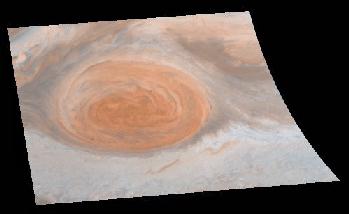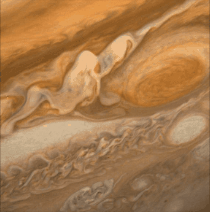 |
 |
| A Galileo "true color" image of the Great Red Spot in 1996 (Ref) | Turbulence near the Great Red Spot |
The Great Red Spot is a great anti-cyclonic (high pressure) storm akin to a hurricane on Earth, but it is enormous (three Earths would fit within its boundaries) and it has persisted for at least the 400 years that humans have observed it through telescopes. Since it is anti-cyclonic in Jupiter's Southern hemisphere, the rotation is counterclockwise, with a period of about 6 days. (A hurricane in Earth's Southern hemisphere rotates clockwise because it is a low pressure system.) The clouds associated with the Spot appear to be about 8 km above neighboring cloud tops. The following two figures show a recent Galileo view of the Great Red Spot, and a closeup of the turbulence in its vicinity.
 |
 |
| A Galileo "true color" image of the Great Red Spot in 1996 (Ref) | Turbulence near the Great Red Spot |
The Coriolis effects that are responsible for cyclones and anti-cyclones on Earth are greatly magnified on Jupiter, which has a rotational frequency about 2 1/2 times that of Earth, but this alone would not account for the persistence and size of the Great Red Spot. There are other features similar to the Great Red Spot on the surface (note the white spots in the above images) but none are as large as the Great Red Spot.
Presumably the persistence of the Great Red Spot is related to the fact that it never comes over land, as in the case of a hurricane on Earth, and that it is driven by Jupiter's internal heat source. Computer simulations suggest that such large disturbances may be stable on Jupiter, and that stronger disturbances tend to absorb weaker ones, which may explain the size of the Great Red Spot. Furthermore, as for the clouds in general, we do not understand fully the reason for the coloring. It has been suggested that certain compounds of phosphorous are responsible for the reddish-brown hue, but this remains somewhat speculative. Thus, we understand the broad properties, but not all the detailed features of this remarkable phenomenon.